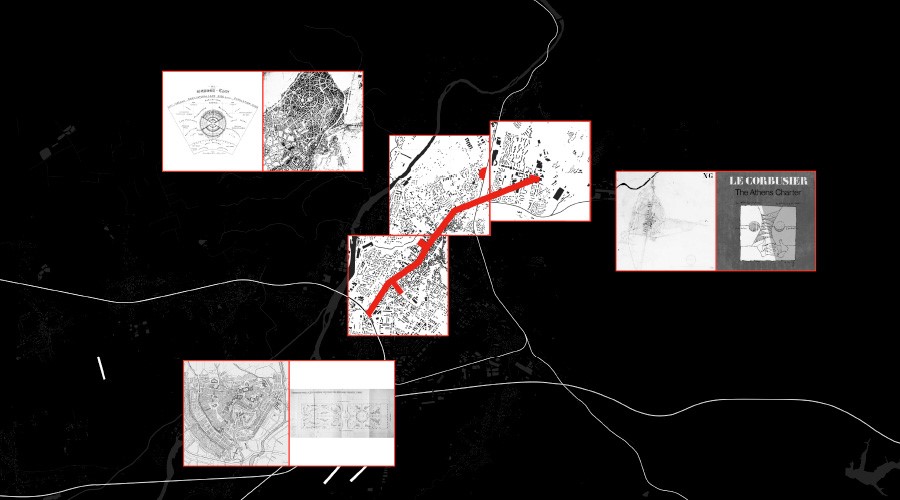PhD Top Stories
Valentina Rodani
Being Modern beyond the Conflict: the Architecture of Void in Gorizia and Nova Gorica
Doctoral Programme in Civil-Environmental Engineering and Architecture (interathenaeum University of Trieste–University of Udine)
The year 1933 is an emblematic moment inward the architecture and modern culture of the interwar period; more precisely it manifests the whole body of contradictions and telluric forces that would have burst in Europe less than a decade later and beyond. In Wien the revolutionary architect of the Goldman & Salatsch house, which daringly faces the Hofburg in Michaelersplatz, died. In Berlin, the Gestapo dreadfully closed and seized the Bauhaus school, ending its project without any way out except for its exodus. In Moscow, the planned IV Congrès Internationaux d’Architecture Moderne had been cancelled. Nevertheless during the summer of the same year, an international group of architects boarded on the steamboat Patris II, leaving Marseille on July 29th to reach Athens on August 13th. This mythological and controversial voyage would late have given birth to the programmatic manifesto of modern urbanism and its exemplary fragment, the Athens Charter. At the IV CIAM opening, Sigfried Giedion stated: «If we travel to Greece, this does not mean an escape; we do not want in any way to escape the difficulties of reality, but always attentive to the deep problems that are going to develop, we want to take a moment of reflection.» However, some significant absences characterized this founding moment. First of all, the Soviets, but also Mies van der Rohe and Walter Gropius, who sent a letter to the secretary of the Ciam to inform him of his condition, closing it with a warning «cultivez votre jardin.» It is tangible that, even during one of its founding moments, the project of modernity is deeply intertwined with contrasts.

Figure 1 - Interpretative figure-ground mapping
Concurrently, elsewhere northern and remote concerning the Mediterranean but also on the front of the Italian landscape, the contradictions mentioned above manifested in the rewriting process of the formerly traumatized territory of Isonzo-Soca river. Gorizia already experienced a profound ideological transformation by means of its architecture, but, conversely to the several monumental projects that were still changing the city, the design of a residential villa expressed an alternative form of thought. Villa Schiozzi, designed by Umberto Cuzzi in 1933, could be in fact considered one of the direct materialization of modern architecture in this borderland. Within this context of conflict between ideologies and ideals, which permeated thoughts as well as facts and artifacts, architectural theories and practices produced several hypotheses that have been realized only afterwards. In the case of Gorizia and Nova Gorica, the urban system has been assembled by fragments rather than total plans, either materialized through exceptions rather than rules. Thus, starting from the recognition of the complex nature of the modern project, this paper traces a trajectory to investigate the hidden layers of its spatial realm and discourse. The project of modernity could reveal its prospective and unfinished condition. Indeed, the permanence and the countless variation of the void will be explored within the multiple garden cities imagined, designed, built and lived in the territory of Gorizia and Nova Gorica. Reckoning with the modern spatial discourse, from the symbolic and figurative aspects of the Athens Charter to the theories of Ebenezer Howard's Garden Cities of Tomorrow and Camillo Sitte's Der Stadte-Bau, heterogeneous city images emerged on the isontine ground: from the therapeutic vision of an Austrian Nice, to Antonio Lasciac's projections for a garden Gorizia, or the green and functionalist Nova Gorica by Edvard Ravnikar.
Reading these fragments archaeologically in their symbolic and figurative aspects, it is therefore possible to reconstruct the origin of a condition sometimes narrative, sometimes projective, certainly partial, transitory and alternative but that has been confronted with the symbolic horizon of his vision. The void is then a critical device of the existing city, of the multiple and superimposed ideas of imagined cities, or localized utopias, of those realized and lived in the territory of Gorizia and Nova Gorica, which can be read as the dispositive of the modern eye, or, the invention of a landscape.
Authors and affiliations
Valentina Rodani1,Contact
Valentina Rodani, email: valentina.rodani@phd.units.itReference
Valentina Rodani"Being modern beyond the conflict: the Architecture of void in Gorizia and Nova Gorica", Mapping the Spaces of Modernist Cities within the Context of CIAM’s Athens Charter, Nova Gorica, March 11–13, 2020; 45–49
DOI: 10.3986/9789610504344
Informazioni aggiornate al: 29.6.2020 alle ore 11:11
Contact: Webmaster - Università di Trieste pagina curata da: Research Doctorate

Piazzale Europa, 1 - 34127 - Trieste, Italia -
Tel. +39 040 558 7111 - P.IVA 00211830328
C.F. 80013890324 - P.E.C. ateneo@pec.units.it


